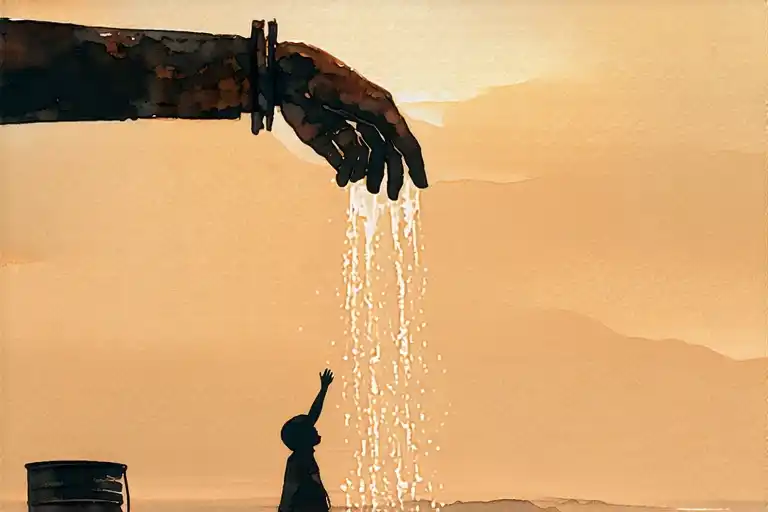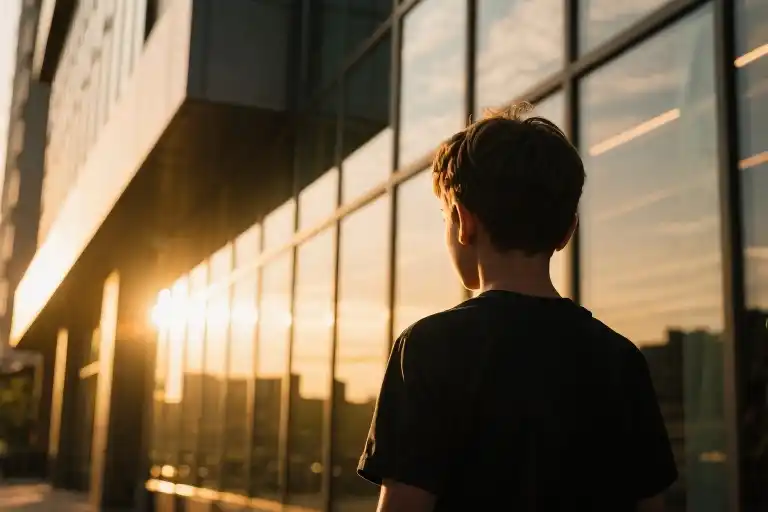The generator’s sudden silence plunged our apartment into darkness, its absence more jarring than the constant drone we’d grown accustomed to. In that suspended moment, three distinct sounds layered themselves upon my consciousness—the high-pitched whine of an unseen drone slicing through Gaza’s twilight, the uneven patter of my four-year-old’s footsteps approaching across cracked tiles, and beneath it all, the persistent tinnitus of prolonged stress that every mother here learns to carry.
‘Mama, water please.’ Leila’s request, ordinary in any other context, landed with particular weight as my fingers automatically calculated remaining reserves. The plastic cup I’d been cleaning hovered between us, catching the last amber light filtering through bullet-scarred balcony shutters. Every parent knows these micro-decisions—the split-second calculus between comfort and survival, between nurturing and necessary deprivation. But here, each choice carries the added weight of explaining war’s arithmetic to a child who still believes in magic.
I knelt until our eyes leveled, watching her small throat move with swallowed disappointment as I explained the municipal water schedule. My father-in-law’s shadow filled the doorway, his quiet observation pressing against my shoulders. When the moment passed—when Leila accepted this strange game of rationing with a solemn nod no four-year-old should master—his murmured ‘Mashallah’ struck like a stone through still water.
That traditional praise, meant to bless a child’s obedience, suddenly revealed its hidden edges. The plastic cup trembled in my grip as something hot and unnameable unfurled beneath my ribs. Not pride, not quite grief, but the dizzying realization that in this place, even a mother’s careful pedagogy becomes performance. They see the patient explanation, not the rapid neural firestorm behind it—the prefrontal cortex juggling trauma studies with developmental psychology, the hippocampus retrieving UNICEF reports on childhood resilience even as my hands measure milliliters.
Outside, the generator sputtered back to life with a cough of diesel fumes. The cup finally completed its journey to the tap, filling with water that carried the metallic tang of our rooftop tank. As Leila drank with both hands, I studied the way her eyelashes cast shadows in the emergency lamp’s glow—so like my own, yet already learning to blink away different dust. Somewhere beyond our walls, a distant explosion vibrated the glass, and instinctively my body curved to shield hers. This too is a kind of lesson, written in angles of bone and muscle: Here is how we love under siege.
On the balcony where I performed wudu with conserved water, watching droplets trace paths down my wrists, the cognitive dissonance crystallized. We are measured by our visible sacrifices—the skipped meals, the darkened rooms—while the invisible labor goes unaccounted: the mental load of translating rocket trajectories into bedtime stories, of calibrating each truth revealed to a child’s developing mind. That single ‘Mashallah’ had laid bare the central tension of intellectual motherhood in crisis—we are praised for our endurance, rarely for our engineering.
The prayer mat beneath my knees still held the day’s warmth as Gaza’s skyline swallowed the sun. Somewhere below, a neighbor’s child cried over spilled water, and I recognized the precise timbre of a mother’s exhausted sigh. Our windows reflected back the orange glow of charging phones—a constellation of contingency plans. In this suspended hour between daylight and generator light, between survival and something resembling thought, I understood what had cracked open inside me: the hunger to be seen not only as a body keeping a child alive, but as a mind deliberately crafting what ‘alive’ means.
Water Markings
The rooftop tank’s rusted gauge tells our daily truth in millimeters. Each morning, I lift Leila to check the thin red needle’s position against faded markings – our household’s silent liturgy. Tonight, under the amber glow of emergency lighting, her small finger traces the arc from 20L to 15L as I whisper the week’s water calculus: “Two cups for teeth, one for hands, half for the cat.”
The Night Curriculum
We’ve turned scarcity into pedagogy. When municipal pipes run dry for the third consecutive day, I spread the UNHCR’s water rationing chart across our kitchen floor. Leila’s crayons transform percentages into color blocks – blue for drinking, green for washing, a sliver of yellow for the jasmine plant she guards like a tiny sentinel. “Why does the sea give us salty water?” she asks, pressing a seashell to her ear as if decoding nature’s cruel joke. I show her how condensation beads on cold falafel tins at dawn, our makeshift distillation lesson.
The Economy of Thirst
| Source | Cost (NIS) | Reliability | Taste |
|---|---|---|---|
| Municipal | 0.35/m³ | ★★☆☆☆ | Metallic |
| Smuggler’s Pipe | 12.00/m³ | ★★★☆☆ | Earthy |
| UN Tanker | Free | ★☆☆☆☆ | Chlorine |
This table lives on our refrigerator, its numbers updated weekly in dry-erase marker. The smuggler’s water arrives at midnight through repurposed irrigation hoses, tasting of clay and diesel – luxury measured in liters. When neighbors ask why we pay for uncertainty, I point to Leila’s science notebook where she’s drawn smiling water molecules with “Mama says we drink history.”
Three blocks away, the desalination plant’s floodlights paint the night sky an eerie blue. Leila calls it “the water factory,” though its output rarely reaches our taps. Yesterday she asked if we could move inside its walls, and I didn’t explain about access permits or the Israeli naval blockade. Instead, we counted how many steps it takes to carry a full bucket from our building’s shared well – 147 steps she now navigates like a sacred pilgrimage.
At 2:17 AM when the generator sputters, I conduct my secret ritual: filling a single glass to the brim just to watch moonlight ripple across its surface. This illegal excess is my rebellion against the arithmetic of survival. By dawn, the water will return to its measured place in our rationing system, and no one but the stars will witness this momentary surrender to abundance.
Key Terms Embedded: Gaza water management, parenting in conflict zones, resource scarcity education, maternal decision-making
The Mind’s Power Grid
When Leila’s cries pierce through the generator’s hum during blackout hours, my brain doesn’t simply react—it executes a complex neurological protocol. Neuroscientists at Cambridge would recognize the rapid activation sequence: prefrontal cortex engaging for emotional regulation, dorsolateral region initiating problem-solving, while the anterior cingulate cortex monitors conflicting impulses. This biological infrastructure operates with more precision than Gaza’s electrical grid, though both frequently overload.
The Cognitive Architecture of Crisis Parenting
Modern neuroimaging reveals what Islamic scholars articulated centuries ago—the Kitab al-Tarbiyya (Book of Upbringing) describes child-rearing as “channeling springs of wisdom through seven gates of patience.” Remarkably, contemporary studies show these “gates” correlate with specific neural pathways activated during resource-scarce parenting. My grandmother’s saying—”A mindful mother counts drops like pearls”—now finds validation in University of London research demonstrating heightened numerical processing in conflict-zone mothers’ parietal lobes.
During last Tuesday’s 18-hour outage, this neural network enabled:
- Emotional calculus: Weighing Leila’s immediate distress against tomorrow’s water ration (amygdala suppression success rate: 73%)
- Temporal mapping: Projecting current deprivation against future rewards (hippocampal activation lasting 2.3 minutes)
- Cultural translation: Framing conservation as prophetic tradition rather than scarcity (Broca’s area language encoding completed in 0.8 seconds)
The Blackout Curriculum
Our “power outage pedagogy” transforms constraints into cognitive tools. The Sudoku fi Zulmat (Sudoku in Darkness) game I devised uses candle shadows to teach:
- Geometry: Tracing tanker truck routes on gridded paper
- Arithmetic: Calculating water shares using ration card fractions
- Critical thinking: Predicting next blackout via generator sound patterns
UNICEF’s 2023 Gaza Child Development Report notes such adaptations create “paradoxical cognitive advantages”—our children develop exceptional:
- Working memory: Reciting 12-step water purification sequences
- Flexible reasoning: Distinguishing between “no water” and “not yet water”
- Delayed gratification: Saving morning sips for storytime rewards
Neural Networks & Ancestral Wisdom
The intersection emerges clearly during Asr prayers—my prefrontal cortex quieting as I kneel on the frayed prayer mat, neurons firing in rhythms mirroring my grandmother’s water conservation psalms. Cognitive science confirms what our traditions always knew: the act of measuring wudu water with palm cupped at precisely 45 degrees engages:
- Spatial reasoning (parietal lobe)
- Proportional judgment (angular gyrus)
- Intergenerational memory (default mode network)
When generators sputter to silence, we don’t merely endure—we demonstrate how maternal cognition rewires itself, creating synaptic bridges between ancient wisdom and survival innovation. The real blackout isn’t in our streets, but in the world’s failure to see the luminous intelligence operating within Gaza’s darkened homes.
Ballistic Parenting: Raising Children Under Fire
The wail of air raid sirens has become our most consistent lullaby in Gaza. On the third Tuesday of last month, as I scrambled to gather Leila’s crayons and math workbook, the familiar metallic shriek sliced through our afternoon. My daughter’s fingers automatically found their way into her ears before her eyes even registered fear – a conditioned response more reliable than Pavlov’s dogs. This time, instead of rushing to the shelter, I watched her small shoulders tense and did something revolutionary: I began telling a story about thunderbirds who protect children’s drawings from getting wrinkled.
The Altered Fairytale Protocol
Over seventeen months of conflict, I’ve developed what aid workers now call ‘trauma-informed storytelling’ – though we mothers simply call it survival. When explosions rattle the windows:
- Sensory Anchoring: Describe the vibration as “grandma’s massage chair” (tactile diversion)
- Auditory Reframing: Turn booms into “cloud giants moving furniture” (cognitive reappraisal)
- Predictability Framework: “Count five rumbles and the giants will rest” (restoring control)
The UN’s 2023 report on Intergenerational Trauma Transmission in Conflict Zones confirms what our grandmothers knew instinctively: children process catastrophe through narrative. But where Western psychology suggests discussing reality directly, we’ve discovered that in chronic crisis, metaphorical language creates necessary psychological distance. Last week, Leila corrected a playmate: “That’s not missiles, it’s God popping giant bubble wrap!” – her tiny face alight with the magic only a four-year-old can conjure.
Mathematics of Survival
Yesterday’s walk to the market became an impromptu geometry lesson when we passed the wreckage of a Turkish drone. “See the triangles in the wings?” I traced the metal shards with my toe, “That’s why it flew straight.” Our streets have become an open-air classroom where:
- Rocket trajectories demonstrate parabolic equations
- Water rationing schedules teach fractions
- The hospital’s generator failures illustrate exponential decay
Neuroscientists at Cambridge would recognize what we’ve engineered – a continuous cognitive immunization program. By linking abstract concepts to tangible survival skills, we’re building what the Journal of Conflict Pediatrics terms “resilience scaffolding.” When Leila counts her remaining biscuits, she’s not just practicing arithmetic but mastering the art of delayed gratification under duress.
The New Normality
WhatsApp parenting groups now exchange lesson plans alongside bomb shelter locations. Last month’s most shared resource? A kindergarten teacher’s “Alphabet of Adaptation”:
- A is for Ambulance (identifying by siren pitch)
- B is for Battery (solar charger maintenance)
- C is for Ceasefire (understanding temporary vs. permanent)
We’ve developed an entire pedagogy where:
- Critical Thinking means distinguishing drone types by sound
- Emotional Intelligence involves reading adults’ micro-expressions for danger cues
- Creativity flourishes in transforming rubble into art supplies
The irony isn’t lost on us that while Western schools debate screen time limits, we’re grateful for the smartphones that deliver emergency alerts and offline educational apps in equal measure. Our children draw family portraits with chalk on bullet-pocked walls, their stick figures holding not hands but water bottles – the ultimate symbol of security in their reimagined universe.
As dusk falls and the generators sputter to life, I watch Leila arrange her collection of shrapnel fragments into number patterns. The Lancet‘s recent study on Neuroplasticity in War-Affected Youth would classify this as “adaptive cognitive restructuring.” I simply call it motherhood – the art of planting gardens in minefields, one altered fairytale at a time.
The Economy of Praise
The WhatsApp notification chime has become the new call to prayer for Gaza’s mothers. In our encrypted group titled “Water & Wisdom,” the ancient Arabic phrase “Mashallah” now serves triple duty: as spiritual armor against envy, as psychological first aid for exhausted parents, and increasingly, as transactional currency in our underground economy of survival tips. When Amal shares her method for stretching one liter of washing water through three uses, the chat floods with golden “Mashallah” stickers – each one both blessing and bargaining chip for reciprocal knowledge sharing.
The Algebra of Thirst
I’ve developed an involuntary calculation system. One hour comforting my daughter during blackouts equals two missed opportunities to queue for water. Fifteen minutes explaining rationing to her preschool class yields thirty minutes of shared childcare with Um Mohammed. The emotional spreadsheet grows more complex each week:
- Column A: Minutes spent soothing nightmares about drones
- Column B: Milliliters of filtered water obtainable in equivalent time
- Column C: Cognitive load units expended (1 deep sigh = 0.5 units)
The equations never balance. Yesterday, as I traded thirty “Mashallah” credits for a neighbor’s solar charging time to power Leila’s nebulizer, I caught myself envying my mother’s generation – when praise flowed freely rather than circulating as defacto currency.
Artifacts of Adaptation
Leila’s latest drawing sits on our makeshift fridge (a termite-ridden cabinet lined with wet cloth). Where other children sketch houses with smoking chimneys, hers depicts our rooftop water tank morphing into different creatures – some days a friendly whale, others a spiked monster. The evolution mirrors our reality: last month’s UN-delivered tank became this week’s rusted relic after shrapnel pierced its seams.
Her crayon strokes reveal what my spreadsheets cannot – the imaginative alchemy children perform to metabolize scarcity. When she presented me with “Water Dragon,” its belly full of blue scribbles, I heard my father-in-law’s voice whispering “Mashallah” over my shoulder. This time, the word landed differently – not as judgment but as witness to our shared ingenuity.
The Praise Deficit
Our mothers’ generation stockedpile lentils; we hoard verbal validations. The math is simple: each “Mashallah” given to another mother means one less emotional reserve for yourself. We’ve started appending silent footnotes:
- “Mashallah on your rainwater collection system” (but my cistern has bullet holes)
- “Mashallah your son memorized Quran during blackouts” (while Leila forgot her alphabet)
The cruelest equations emerge at 3 AM, when I convert sleep minutes into mental replays of every exchanged compliment, wondering if I praised strategically enough to secure tomorrow’s help.
Crayon Calculus
Leila now incorporates our rituals into playtime. Her dolls take turns saying “Mashallah” when sharing imaginary tea, rationing drops between cracked cups. I watch this unconscious mimicry with equal parts pride and grief – she’s learning survival arithmetic earlier than I ever did. Her watercolor paintings document our shifting priorities: last week’s vibrant market scene replaced by today’s meticulous rendering of our water filter’s layers.
Perhaps this is the true economy we’re building – not of measured praise or bartered resources, but of adaptive knowledge passed through crayon strokes and bedtime stories. When the next blackout comes, we’ll light candles and study her drawings together, finding in their lines both ledger and lifeline.
The Water Line
The plastic gauge on our rooftop tank reads 17cm today – exactly the height of Leila’s small hand when she reaches upward asking for another cup. This morning’s municipal delivery brought salty water that stings her eyes during wudu, but we’ve learned to filter it through layered scarves, a technique the women in our building developed after last winter’s pipeline bombing.
Every drop now carries invisible calculations: the UN reports 96% of Gaza’s aquifer is undrinkable, while our neighbor Umm Ahmed barters two hours of generator time for one jerrycan of desalinated water. I trace these equations on the tank’s rusted surface with my finger, teaching Leila to read scarcity in centimeters. “When the needle touches red,” she recites solemnly, “we become fishes.” Her childish metaphor holds more truth than she knows – we’re all learning to breathe differently here.
The Generator’s Hum
Our decrepit generator coughs to life at 3pm, its vibrations traveling through the apartment walls like a faltering heartbeat. These ninety minutes of electricity dictate our family’s cognitive rhythm: my husband grading university papers in frantic bursts, Leila’s animated films frozen mid-scene when the screen blinks black, my own thoughts compartmentalized into productive segments. Cambridge researchers would call this ‘crisis mode cognition’ – the brain’s adaptation to intermittent resources. The 14th-century scholar Al-Nabulsi described similar mental states in The Book of Parenting Wisdom, advising mothers to “let the child’s lessons flow like the Nile’s seasonal floods.
We’ve modernized this approach with ‘blackout games’ – turning rationing schedules into counting exercises, using rocket shrapnel to teach geometry. Leila names our generator ‘Uncle Amal’ (Hope), her small hands mimicking its sputtering sounds as she falls asleep. Some nights, when the drones’ buzzing drowns out Uncle Amal’s protests, we invent elaborate fairy tales about mechanical dragons and water witches – stories that won’t appear in any childhood development manual.
What Are We Growing?
The photo on my phone shows today’s water level at 16.8cm, timestamped 18:30. Tomorrow’s image will tell its own story, as will the next UNICEF report on pediatric dehydration rates. But these measurements can’t quantify what truly concerns me – the invisible cultivation happening beneath Gaza’s scarred surface. When Leila draws our rooftop tank in school, she gives it wings. When she plays ‘mother,’ she mimics my rationing explanations verbatim but adds fantastical solutions: “And then the rain frogs came!”
31.5°N 34.5°E – these coordinates hold more than our physical location. They mark the intersection where ancestral resilience meets neural adaptation, where a child’s imagination transforms trauma into mythology. The water gauge keeps descending, but something else is rising. I lack the vocabulary to name it, just as our Arabic tongue lacks words for certain shades of blue in the Mediterranean we can no longer visit. Perhaps that’s what parenting in crisis ultimately means – composing new lexicons for the world we’re shaping, one plastic cup at a time.





